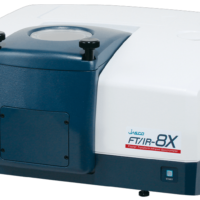There are various measurement methods in FTIR spectroscopy, and these are summarized below.
Transmission methods
KBr tablet method
This method is used for powder samples, and precise measurements can be performed even with very small samples. However, due to the fact that KBr absorbs moisture, it is not suitable when measuring samples whose spectra contain absorption bands in the same regions as those due to water. Samples that contain water, are highly hygroscopic, have a high concentration of carbon or pigments, have an unstable crystal structure, or are relatively opaque to infrared light, are also unsuitable. For chlorides and hydrochlorides, since a halogen exchange reaction occurs between Br and Cl, sample pellets are generally produced using KCl.

Fig. 10 KBr tablet method
Nujol method
A powder sample is mixed with liquid paraffin to form a paste, which is then applied to the window plate. The Nujol method is used for samples that are not suitable for the KBr method, such as those that absorb moisture during sample preparation (e.g., sugars), and samples that do not dissolve in solvents (e.g., inorganic substances). It is also used for reagents specified by official standards such as pharmacopoeia, or for far-infrared measurements under a N2 gas purge. However, this method is not suitable for evaluating bands associated with CH groups (3,000 to 2,800, 1,500 to 1,300 cm-1) because of absorption by the liquid paraffin in these wavenumber regions.

Fig. 11 Nujol method
KBr plate method
This method uses crystalline KBr. A powder sample is sandwiched between KBr plates and measured. Since there is no need for crushing, sample preparation is easy. It is an effective method when simple sample preparation is required, or for measuring highly hygroscopic samples. However, samples that contain large particles are susceptible to scattering of light, so the measured absorbance may be lower than the true value. This method cannot be used for samples containing water.

Fig. 12 KBr plate method
Thin-film method
This method is for samples that can be formed into thin films with a thickness of 10 μm or less. Various thinning methods can be used, such as stretching, hot pressing, and cutting. If the sample is soluble in a solvent, the solution can be applied to an infrared transmitting material (KBr plate), and evaporating the solvent to form a thin film becomes simple.

Fig. 13 Thin-film method
Liquid-film method
This method is suitable for samples of non-volatile liquids that have a high viscosity, and also for qualitative analysis. The liquid is held between two window plates in the assembled cell. Depending on the peak intensity, a spacer may be needed to adjust the optical path length. For samples containing water, a KBr window cannot be used.
Solution method
This method can be used to measure volatile solutions or to analyze the concentration of trace additives dissolved in a solution. Before performing the measurements, it is important to ensure that the solvent itself does not give rise to absorption bands that interfere with those of the target components
Gas method
This method is used for gaseous samples. The cell path length should be adjusted based on the gas concentration. Since gaseous samples usually produce sharp absorption peaks, high-resolution measurements are required. To determine the amount of water vapor and carbon dioxide in a sample, use an optical system that is under a full vacuum, or perform a N2 gas purge to remove these components completely.

Fig. 14 Gas method






